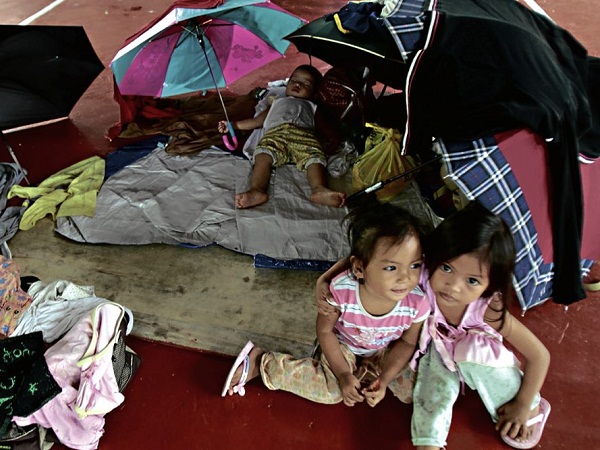Evacuees return home to mud-caked piles of garbage

SUFFER THE LITTLE CHILDREN. Mia, 2; Ashley, 3; and Aki, 2, keep close to each other at their temporary home in Malanday Elementary School in Marikina. GRIG C. MONTEGRANDE/Philippine Daily Inquirer
When evacuees who sheltered at a school in a badly flooded suburb of Manila were told on Friday to return to their homes, Luzviminda Limas worried where her family would sleep.
Her home is a 24-square-meter box that has a rough concrete floor and a tin roof, with no ceiling. The lower half of its walls is made of flimsy cinder blocks and the upper half of warped cardboard and tarpaulin.
The Marikina River, normally about 200 meters from her house, was swelled by torrential monsoon rains, and the water reached within centimeters under the roof of her house. It deposited thick mud half-knee deep as it receded early Thursday.
A 54-year-old widow, Limas said the floods brought back memories of the 2009 deluge when she was huddled under an umbrella with one of her daughters and her 4-month-old grandson on the roof of a nearby daycare center as typhoon floodwaters destroyed her home.
When the water rose early last week, Limas hustled her family to the same elementary school in Nangka village where they found emergency shelter in 2009.
School prepares to open
More than 7,000 evacuees sheltered at Nangka Elementary School in Marikina City during the recent floods. But principal Marciana de Guzman said they were told to leave so the school could be prepared for the resumption of classes this week.
Limas works doing laundry and shares her home with her two unemployed daughters and their husbands—one a mini-bus driver and the other a laborer who is currently out of work. Each of her daughters has two children, one only 8 months old.
She worried where everyone would sleep on Friday night when they return home because everything was wet and muddy.
Her daughter, Venice, was collecting cardboard boxes to use as sleeping mats.
“I wish we could have a new home, one that has decent walls not made of cardboard,” she said. “We have nowhere to go. If we had money, we would leave this place.”
Resettlement
Her community is a resettlement site for hundreds of poor families in Marikina, the “shoe capital” of the Philippines, said City Council member Judy Magtubo.
Magtubo said many of the shoemakers who lost their livelihood had not yet recovered from the devastation of the 2009 floods, which was then the worst flooding in the metropolis in 40 years.
The torrential monsoon rains that lasted from Aug. 6 through Aug. 8 forced more than 360,000 in Metro Manila and nearby provinces to flee their flooded homes and seek shelter in schools, churches and government buildings. At least 77 people died, many from drowning.
Nowhere to go
Civil Defense Chief Benito Ramos said some evacuees had returned home but many others remained in the shelters because their houses had been destroyed.
“They have no homes to return to, they have no food, they have no clothes except what they are wearing,” he said.
Residents using anything from shovels to pieces of plywood scraped the debris off the floors of their houses and the pavements and gathered them into mud-caked piles of garbage on the side of the street.
“It’s really an eyesore when we saw it from the helicopter,” Ramos said. “There will be no more rescue. It’s now ‘Operation Cleanup.’”